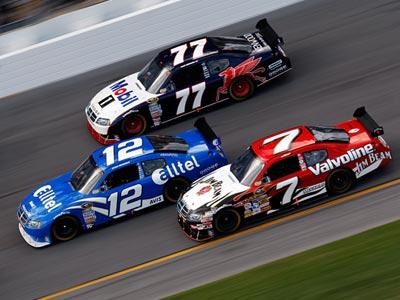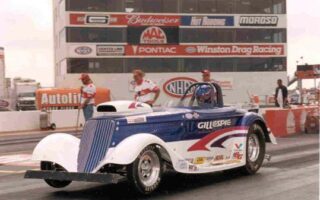Rev your engines and buckle up for a thrilling ride through the high-octane world of stock car racing. From the roar of the engines to the smell of burning rubber, stock car racing is more than just a sport; it’s a vibrant tapestry of speed, strategy, and spectacle. Originating in the dusty backroads of America, this adrenaline-fueled pastime has evolved into a multi-billion-dollar industry, captivating millions of fans around the globe. In this article, we will explore the history, intricacies, and cultural impact of stock car racing, shedding light on what makes this exhilarating sport a cornerstone of motorsport enthusiasts’ hearts. Whether you’re a seasoned fan or a curious newcomer, get ready to dive deep into the lanes that lead to both glory and drama on the asphalt.
Table of Contents
- Exploring the Evolution of Stock Car Racing and its Cultural Impact
- Understanding the Mechanics of Stock Cars for Enhanced Performance
- The Role of Strategy and Team Dynamics in Winning Races
- Engaging with Fans: Building a Community Around Stock Car Racing Events
- Q&A
- To Wrap It Up
Exploring the Evolution of Stock Car Racing and its Cultural Impact
The journey of stock car racing is a fascinating tale of transformation, deeply intertwined with American culture. Beginning in the rural heartlands during the 1940s, the sport arose from the need for bootleggers to outpace law enforcement during the Prohibition era. As those modified cars took to the dirt tracks, they laid the foundation for a new kind of racing that celebrated speed, skill, and a rebellious spirit. Over the decades, this pastime evolved into a professional sport, captivating audiences and giving rise to iconic venues like Daytona and Talladega. The evolution is marked by milestones such as the introduction of NASCAR in 1948, which provided a structure for competitive racing and established stars like Richard Petty and Dale Earnhardt who became cultural icons in their own right.
The cultural impact of stock car racing extends far beyond the racetrack. This sport has fostered a unique sense of community among its fans and participants, often characterized as a blend of loyalty and rivalry. Festivals, tailgating parties, and family gatherings during race weekends are a testament to its social significance. Additionally, stock car racing has influenced various aspects of American life, from fashion—think of the vivid team colors and merchandise—to music, as songs celebrate the thrill of the race and the heroes behind the wheel. This cultural phenomenon has also inspired elements in film and literature, encapsulating the thrill of the asphalt and the profound connection between the racers and their supporters.
| Decade | Key Evolution | Cultural Significance |
|---|---|---|
| 1940s | Origin of stock car racing | Grassroots community of racers |
| 1960s | NASCAR’s rise | Emergence of racing legends |
| 1980s | Television broadcasts | Mainstream popularity surge |
| 2000s | Global expansion | International fan base growth |
Understanding the Mechanics of Stock Cars for Enhanced Performance
To truly appreciate the thrill of stock car racing, one must delve into the intricate mechanics that drive performance on the track. Each vehicle is a finely-tuned machine designed for optimal speed, agility, and safety. The main components that contribute to a car’s efficiency include:
- Engine Specifications: Most stock cars utilize V8 engines, which deliver immense horsepower and torque.
- Suspension Systems: Sophisticated suspensions allow for better handling, absorbing shocks from uneven surfaces.
- Aerodynamics: Smooth contours and rear wings reduce drag, enhancing high-speed stability.
- Tires: Specialized racing tires offer maximum grip and are designed to withstand extreme conditions.
- Weight Distribution: A balanced weight distribution secures optimal traction and cornering capabilities.
Another critical aspect is how teams tune the cars to suit specific tracks and conditions. Through a combination of data analysis and experimental adjustments, pit crews can modify various parameters such as:
| Parameter | Impact |
|---|---|
| Ride Height | Affects aerodynamics and center of gravity. |
| Gear Ratios | Optimizes acceleration vs. top speed. |
| Corner Weight | Enhances cornering stability and grip. |
The Role of Strategy and Team Dynamics in Winning Races
In stock car racing, victory is often the product of meticulous strategy and cohesive team dynamics. Effective race strategies are not merely about speed; they incorporate tire management, fuel economy, and race pace. Teams analyze data meticulously to predict the optimal moments for pit stops and make split-second decisions based on track conditions and competitor behavior. The strategy must be flexible enough to adapt to evolving race circumstances, allowing drivers to capitalize on opportunities and mitigate risks. This planning must reflect a deep understanding of the car’s performance and the nuances of the racetrack, ensuring that every twist and turn is navigated with precision.
Furthermore, the synergy between team members is paramount in executing these strategies. Each individual, from the crew chief to the pit crew, plays a critical role in ensuring the car’s performance is maximized. Effective communication and trust within the team fosters an environment where every member feels empowered to contribute to the race’s outcome. Teams often conduct debriefing sessions to assess previous performances and strategize for upcoming races. This ongoing collaboration results in a well-oiled machine that can respond dynamically to the challenges of race day. Here’s a look at some key team roles and their contributions:
| Role | Key Contribution |
|---|---|
| Crew Chief | Oversees race strategy and pit stops |
| Spotter | Guides the driver on track positioning |
| Pit Crew | Executes quick tire and fuel changes |
| Data Analyst | Tracks performance metrics and informs strategy |
Engaging with Fans: Building a Community Around Stock Car Racing Events
Creating a vibrant atmosphere around stock car racing events involves more than just thrilling races; it is about fostering a sense of belonging among fans. One effective strategy is utilizing social media platforms to engage with the community. By sharing behind-the-scenes content, race day preparations, and fan stories, you can cultivate excitement and anticipation. Consider hosting live Q&A sessions or virtual meet-ups with drivers, allowing fans to connect on a personal level. Engaging polls and fan art showcases can also enrich the experience. The following ideas can be integrated into your social media strategy:
- Live updates from the pit crew during races
- Fan-featured posts highlighting their favorite moments
- Interactive quizzes about racing history and statistics
- Exclusive sneak peeks of new merchandise or car designs
Moreover, promoting local gatherings at the racetrack or fan zones can strengthen community ties. You can organize activities such as car shows, autograph sessions, and live music to draw in fans of all ages. Creating an official fan club or loyalty program can enhance this connection, offering members exclusive benefits like discounted tickets, special merchandise, or experiences. Below is a simple table highlighting potential community-building events:
| Event | Date | Location |
|---|---|---|
| Fan Meet & Greet | June 15 | Main Grandstand |
| Car Show | July 22 | Parking Lot A |
| Racing Trivia Night | August 30 | Trackside Pub |
Q&A
Q&A: The Thrills and Rumbles of Stock Car Racing
Q: What exactly is stock car racing?
A: Stock car racing is a popular form of motorsport that involves modified vehicles racing on oval tracks. Originating in the United States, it showcases cars that are heavily based on production models, but are specifically designed for high-performance racing. The most recognized series is NASCAR, which features well-known events like the Daytona 500 and the Coca-Cola 600.
Q: How did stock car racing come to be?
A: Stock car racing evolved from the practice of bootlegging during Prohibition in the 1920s and 1930s, where drivers modified their cars to outrun law enforcement. These early races soon transformed into organized events, leading to the establishment of official racing circuits in the years that followed, laying the groundwork for the structured sport we see today.
Q: What distinguishes stock cars from other racing vehicles?
A: Stock cars are unique because they maintain the appearance and basic structure of commercially available vehicles, but with significant modifications under the hood. These cars typically have a powerful V8 engine, specialized suspension systems, and safety features like roll cages, making them ideal for high-speed racing while still preserving a semblance of their production counterparts.
Q: What are some of the main types of stock car racing events?
A: Stock car racing features a variety of events, primarily characterized by oval track formats. Races can range from shorter heat events to long-distance endurance races, often incorporating strategies for pit stops, tire management, and fuel conservation. Notably, races can vary in length, with some events covering hundreds of miles, testing both driver endurance and vehicle reliability.
Q: Who are some of the most famous stock car drivers?
A: Stock car racing has produced numerous legendary drivers, including Dale Earnhardt, Richard Petty, and Jeff Gordon. These individuals not only garnered fame for their racing prowess but also helped elevate the sport’s popularity, becoming icons in the realm of motorsports.
Q: How do teams prepare for a stock car racing season?
A: Preparation for a racing season typically begins months in advance, involving extensive vehicle testing, engineering refinements, and strategies for race day. Teams evaluate past performances, make adjustments to meet changing regulations, and develop tailored race strategies based on the unique characteristics of each track.
Q: What role does technology play in stock car racing?
A: Technology is pivotal in stock car racing, from aerodynamics and engine performance to real-time data analytics. Teams utilize advanced equipment and software to gather data during practice sessions and races, which informs adjustments in strategy and vehicle setup. Innovations such as telemetry systems have revolutionized how teams analyze and respond during competitions.
Q: Why do fans love stock car racing?
A: Fans are drawn to stock car racing for its thrilling atmosphere, intense competition, and the sense of community among racing enthusiasts. The excitement of high-speed action, combined with the strategic elements of the sport, creates an electric environment that keeps spectators on the edge of their seats. Additionally, the accessibility of events, whether in person or through broadcasts, contributes to its widespread appeal.
Q: What are the challenges faced by drivers and teams?
A: Stock car racing is fraught with challenges, including the inherent risks of high-speed competition and the pressures of maintaining peak performance. Drivers must navigate not only the physical demands of racing but also the mental game of strategy and quick decision-making. Furthermore, teams face obstacles in vehicle maintenance, sponsorship negotiations, and the ever-changing dynamics of each race.
Q: What is the future of stock car racing?
A: The future of stock car racing looks promising, with the sport continuously evolving to maintain relevance. Efforts to integrate sustainability, such as the adoption of biofuels and electric racing initiatives, are being explored. Moreover, the growing influence of digital media and e-sports is captivating a new generation of fans, ensuring stock car racing remains a thrilling and integral part of motorsport culture.
To Wrap It Up
As the checkered flag waves and the roar of engines fades into the distance, the world of stock car racing remains a vibrant tapestry of skill, strategy, and sheer exhilaration. Whether you’re a die-hard fan cheering from the grandstands or a casual observer captivated by the drama of the track, this sport offers an unparalleled blend of adrenaline and artistry. The stories spun on the asphalt—of triumph and heartbreak, of innovation and tradition—continue to fuel the passion that binds fans and drivers alike. As we look to the future, stock car racing stands poised to evolve, welcoming new technologies and talents while honoring the rich heritage that first ignited its engines. So, buckle up and keep your eyes on the track; there are more laps to run, and each one promises to be more thrilling than the last.



